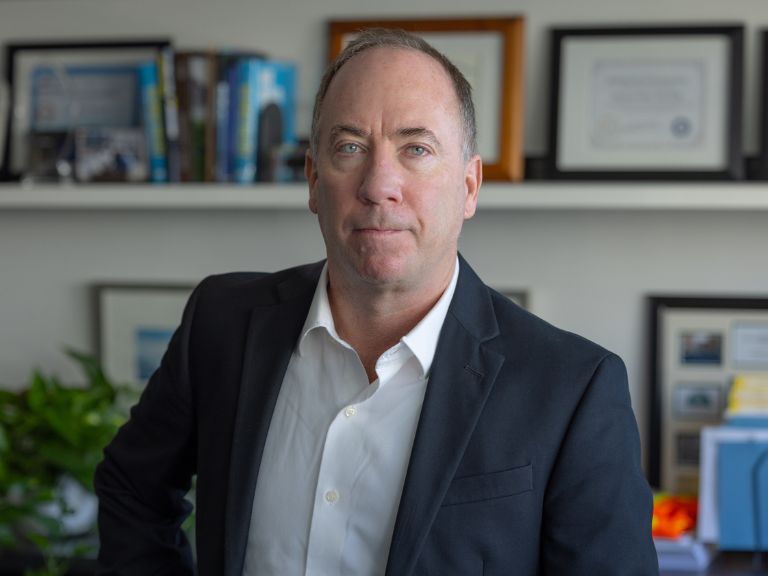The commissioner of the New York City Department of Design and Construction (DDC), Thomas J. Foley ’92, P.E., returned to his alma mater on November 19 to share insights with current Manhattan University engineering students. Entitled DDC’s Vision and Mission: Leading the Way in Public Infrastructure, the lecture was hosted by the School of Engineering.
 Praised as “a steady hand in moments of crisis” when he was appointed to the commissioner role in January 2022, Foley has built a 30-year career in public service. Twenty-seven of those years have been at the DDC, the city’s primary capital construction project manager. He has been front and center in helping the city recover from historic moments of crisis like 9/11, Hurricane Sandy and the COVID-19 pandemic.
Praised as “a steady hand in moments of crisis” when he was appointed to the commissioner role in January 2022, Foley has built a 30-year career in public service. Twenty-seven of those years have been at the DDC, the city’s primary capital construction project manager. He has been front and center in helping the city recover from historic moments of crisis like 9/11, Hurricane Sandy and the COVID-19 pandemic.
Beyond addressing the city’s needs during emergencies, Foley’s work also encompasses New Yorkers’ day-to-day and civic concerns. He oversees the city’s capital construction projects, from animal shelters and libraries to firehouses and community health centers, while ensuring that they are aligned with the city’s resiliency goals.
The Staten Island, New York, native notes that his education at Manhattan University, where he majored in civil engineering, was foundational to his success. Especially vivid is the support he received from Moujalli Hourani, D.Sc., associate professor of civil and environmental engineering.
“I’ll never forget some of Dr. Hourani’s classes,” he says. “I sat down with Dr. [William] Brown, Dr. Hourani and Dr. [John] Horvath at various times because I needed their insight. They instilled a level of confidence in their students to, ‘keep at it, and you will be successful.’”
After graduating, Foley joined the New York City Department of Environmental Protection (DEP). “I had a preference for construction and wanted to be outside,” he recalls. “A good number of our class went to work for the city; we had jobs lined up November of our senior year. I still strive for that now as commissioner at DDC — to start outreach to college students so that when they graduate, they can start as soon as they’re able.”
In 1996, Foley transitioned to the newly formed Department of Design and Construction. Since then, he has worked in every borough of the city in a variety of roles at the agency, including deputy director, director and assistant commissioner in the Division of Infrastructure. After 9/11, he became a project manager for DDC’s World Trade Center Disaster Recovery and Debris Removal Project, reviewing staffing and procedures, analyzing labor and equipment utilization, and identifying and correcting inefficiencies in the $500-million endeavor.
“I remained at the site for about two years,” he says. “During that time, I worked with so many fellow alumni from Manhattan, more so than from any other school, from an engineering standpoint.” He continues, “It had its physical and mental challenges, but everybody was working together to get it done.”
Foley says that his efforts on the 9/11 recovery project were “very similar to public service after Sandy, and the amazing work that my agency was able to perform during the pandemic.”
The DDC’s pandemic-related construction projects included two temporary hospitals, four health labs, three permanent healthcare facilities, and a number of testing and vaccination sites throughout the city.
“Those were all done in record time,” he says. “When the city is in crisis situations, these are some of the things that we always volunteer for.”
During the past decade, Foley has also been responsible for the reconstruction of the Times Square Plaza, as well as the activation of New York City Water Tunnel 3, a 60-mile tunnel that runs from the Hillview Reservoir in Yonkers to Queens. Designed to reduce the city’s dependency on two older water tunnels, it is the largest capital construction project in New York City history.
In January 2017, he was named deputy commissioner of the Public Buildings Division, where he managed the $8.7 billion Borough-Based Jail Program, which aims to replace the Rikers Island complex with four smaller facilities.
Foley is especially proud of the DDC’s work on the East Side Coastal Resiliency Project, a critical coastal protection initiative aimed at reducing flood risk due to coastal storms and sea level rise on Manhattan’s East Side. “It’s the largest resiliency project going on in the country,” he says. “I’m not surprised that New York City is leading the way.”
As he leads a staff of 1,150, with plans to add additional numbers, Foley is bullish on bringing Manhattan University engineers into the DDC fold.
“I encourage graduates to work in the public sector, to give back,” he says. “Working with the city provides so much latitude and mentorship. They learn a lot in those first couple of years, which are so critical both on the design table and then out in the field.”